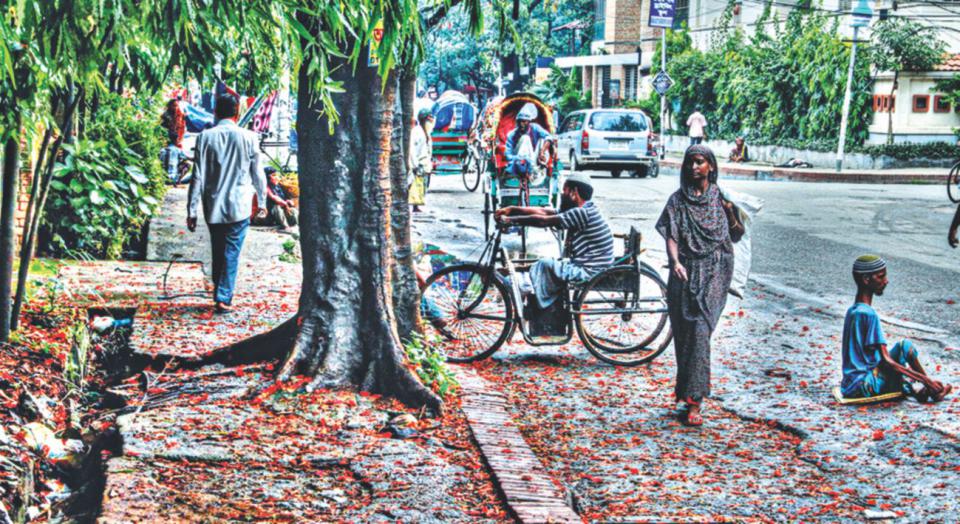Published in The Daily Star on Tuesday, 20 February 2018
Mustafizur Rahman

Bangladesh is well-poised to be considered for graduation from the LDC group at the next review of the UN’s Committee for Development Policy (CDP) in March 2018. As may be recalled, to be eligible for graduation the thresholds for at least two of the three graduation criteria (Human Asset Index, Economic Vulnerability Index and per capita Gross National Income) need to be attained. While a number of LDCs, including from South Asia (Nepal and Bhutan), are expected to be considered for graduation, Bangladesh is likely to have the unique distinction of attaining (and surpassing) the thresholds for all the three graduation criteria by the time the CDP convenes its meeting. This, no doubt, is indicative of the strength of the Bangladesh economy, and lays a good foundation for going forward towards the final graduation out of the LDCs in 2024 following the two successive triennial reviews by the CDP in 2021 and 2024.
No doubt, graduation out of the LDC group will entail a number of challenges for Bangladesh. Consequently, issues of smooth graduation, graduation with momentum and sustainable graduation assume heightened importance for the country. Projections undertaken for a recent study by the Centre for Policy Dialogue (CPD) indicate that, Bangladesh’s graduation is expected to be a smooth one in the sense that in terms of EVI and HAI she will hopefully graduate with significant surplus—in case of EVI (the threshold is 32 or below) Bangladesh’s projected value for 2018 is 24.7; in case of Human Asset Index (HAI- the threshold is 66 or above) she is set to reach the value of 70.9. Thus, if Bangladesh is able to maintain the current dynamics, she will be able to graduate in the year 2024 with significant momentum. Graduation with momentum will enable Bangladesh to ensure that graduation remains sustainable as Bangladesh embarks on its post-2024 developmental journey. It is from this perspective that graduation with momentum is so critically important for Bangladesh. And if this is to be ensured, Bangladesh will need to take adequate preparation so that graduation with momentum leads to sustainable graduation.
While over the next few years 15 LDCs are expected to be considered by the CDP for graduation, graduation of Bangladesh from the group will be keenly observed by the global community, for several reasons. Firstly, as should be noted, for Bangladesh, graduation from the LDC group is a one-way, irreversible journey. While it is conceptually possible for an LDC to revert back to the LDC group following graduation, because of her population size (criteria for LDC inclusion exclude countries with more than 75 million) this is not an option for Bangladesh. Secondly, Bangladesh is one of the very few LDCs which have been able to benefit from international support measures (ISMs) that are in place for the benefit of the LDCs. LDC graduation will, thus, likely have relatively more adverse implications for the globally integrated economy of Bangladesh compared to many other LDCs. Thirdly, Bangladesh stands out quite distinctly among all the LDCs because of the size of her economy (18.3 percent) and population (more than 17.3 percent). Fourthly, Bangladesh’s graduation journey will be taking place at a time of increasing uncertainties in the global arena—global economic slowdown, fall in global export demand, decreasing remittance flows, cut in aid. These will make Bangladesh’s graduation journey a more challenging one.
It may be noted that Bangladesh’s post-LDC journey will be founded on two graduations: LDC graduation and middle-income graduation. As may be recalled, Bangladesh has recently (in 2015) graduated to lower middle-income country (LMIC) group. This will mean that access to highly concessional aid will gradually be substituted by blended and IBRD, relatively high-cost financing at a time when she will need to graduate with momentum. It is also to be noted that graduation of Bangladesh, as also of other candidate LDCs, will take place in the era of the SDGs. This will require triangulation of economic development, social inclusion and environmental sustainability which is a challenging demand from the perspective of the journey ahead for Bangladesh. SDGs call for structural transformation, reduction of inequality and leaving no one behind, creation of decent jobs, reducing gender inequality, sustainable use of land and sea resources. Many of the SDG targets and indicators go beyond LDC criteria of income growth and reduction of human and economic vulnerabilities. Thus, sustainable LDC graduation in the era of the SDGs will be even more challenging.
In view of all these, identifying the implications of the imminent LDC graduation and designing appropriate strategies towards sustainable LDC graduation are of critical importance and do have significant policy relevance for Bangladesh.

At a time when Bangladesh will be considered for graduation in 2018, about 30 million people will still be living below the national poverty line.
WHAT WOULD GRADUATION ENTAIL FOR BANGLADESH?
The support measures portal for the LDCs maintained by the CDP lists 136 LDC-specific International Support Measures (ISMs) across the fields of trade and market access, development finance, transfer of technology and technical assistance. Unless negotiated separately with relevant partners, the ISMs will be phased out in 2024. Four issues stand out in this connection.
Firstly, LDC graduation will entail loss of preferential treatment leading to significant erosion of preferences for Bangladesh. Bangladesh currently enjoys preferential market access in more than 40 countries. Estimates carried out for the aforesaid CPD study indicate that Bangladesh will face an additional 6.7 percent tariffs in absence of LDC treatment resulting in a possible export loss of USD 2.7 billion (equivalent to eight percent of her global export in FY2015). The adverse impacts will be most telling in the EU market where 97.8 percent of Bangladesh’s exports currently enter duty-free. In the EU (and also for example Canada) this will mean an additional 8.7 percent (7.3 percent) tariff facing Bangladeshi goods. In case of apparels, Bangladesh’s key export to the EU for which MFN tariffs are about 12 percent, loss of preferences will significantly reduce her competitive strength. The preference erosion will have consequent adverse implications for export earnings, industrial production and jobs unless compensatory measures are put in place.
Secondly, implications of LDC graduation for Bangladesh’s access to concessional financing are also worth noting. While importance of ODA (USD 2.7 billion in 2017) in the Bangladesh economy has been coming down over the years and currently stands at about one percent of Bangladesh’s GDP, ODA continues to play a significant role in many important sectors of the economy including health and education, and also infrastructure. In recent years, Bangladesh alone has received seven percent of total ODA (average for 2012-15) destined for all the LDCs. Since Bangladesh’s LDC graduation coincides with her middle-income graduation, this will imply notable shift from IDA-type foreign aid (interest of mostly less than 0.75 percent per annum with long repayment period) to blended type of finance which has higher interest and more stringent terms.
Thirdly, having graduated, Bangladesh will not be eligible for support measures accorded to LDCs accorded by multilateral institutions such as the WTO. Special and differential treatment for the LDC members will no longer be available to Bangladesh (in the form of market access, technical assistance, waivers from obligations, protracted implementation period in view of implementing obligations and commitments). Bangladesh will also not be eligible for support for the LDCs under aid for trade, and aid for trade facilitation and support under the enhanced integrated framework (EIF) window of the WTO.
As a recent report by the UNCTAD rightly observes, graduation is the first milestone in the marathon of development, not a winning post of a race to leave the LDC category. Bangladesh should take adequate preparation for the journey ahead. As may be noted here, Bangladesh’s graduation journey will coincide with a period of slow recovery of the global economy following several years of stagnation and slowdown in the aftermath of the financial-economic crises of 2007-8. Bangladesh’s commendable HAI and EVI average scores conceal vulnerabilities in terms of a number of sub-indicators which will require special attention on the part of policymakers, and need targeted resource allocation.
Going forward, building on the record of past performance will be increasingly challenging as hard-to-reach areas and communities get to be targeted to address the formidable vulnerabilities. For example, to achieve further progress in terms of social development indicators, the solutions are likely to be more capital-intensive than the many low-cost solutions of the past and present.
Bangladesh continues to remain a highly challenged country in terms of climate vulnerabilities. While Bangladesh has demonstrated significant success in disaster management, natural disasters remain an uncertain variable in any equation involving the future trends.
Mitigating the impact of climate change should remain high on the policy agenda of Bangladesh. Graduation from the LDC group will likely adversely affect Bangladesh’s likelihood of receiving preferential climate financing from such global sources as infrastructure development fund, climate change adaptation funds and technology-related green climate fund. On the other hand, improvements in standards of living, thanks to higher income levels, will hopefully better equip people in addressing, and adapting to, natural disasters.
That Bangladesh is on track for consideration for LDC graduation is in itself indicative of her robust track record in terms of some of the key macroeconomic and sectoral performance correlates. Crossing the thresholds relating to the three graduation criteria, and maintaining the record, speak of the underlying strengths of the economy and a degree of demonstrated resilience. However, it needs to be conceded that graduation criteria limit themselves to only some selected indicators, albeit important ones. Graduation with resilience, stamina and momentum demands looking beyond an ‘instrumentalist’ approach to graduation, and calls for a need to look at graduation from the broader perspective of structural transformation of the economy in the era of the SDGs that aspires to leave no one behind.
In view of the above, the following section articulates elements of a possible strategy towards Bangladesh’s graduation with momentum and sustainability beyond 2018.
DESIGNING A TRANSITION STRATEGY
Once Bangladesh becomes a candidate-LDC for graduation, UNCTAD will prepare a vulnerability profile for Bangladesh identifying areas that will call for closer attention from the perspective of smooth transition. DESA will also prepare an ex ante impact assessment before the second triennial review. Bangladesh should take advantage of this opportunity to prepare a draft response/comments (although this is optional) which can get the ball rolling in preparing Bangladesh’s envisaged LDC graduation strategy.
STRUCTURAL TRANSFORMATION
At a time when Bangladesh will be considered for graduation in 2018, about 30 million people will still be living below the national poverty line, about half of whom would be living below the extreme poverty line. ‘Lewisian turning point’ of the economy (with shift from agriculture to manufacturing activities in the economy) will still be a journey in the making. Supply-side diversification and shift from factor-driven to productivity-driven economy will continue to remain a challenge for Bangladesh. Bangladesh will need to put high priority on technology upgradation, skills endowment, productivity enhancement and higher competitive strength. Institution and incentives, fiscal and monetary policies, and allocative and use efficiency of resources will need to be geared to address the needs of the structural transformation of the economy.
STRENGTHENING MARKET ACCESS
As was noted earlier, one of the major implications of Bangladesh’s graduation from the LDCs will entail significant loss of preferences currently being enjoyed by Bangladesh as an LDC. MFN (most favoured nation) rates on key exportables from Bangladesh remain relatively high; consequently, likely preference erosion and the resultant loss of competitiveness could be significant. In view of this, Bangladesh will need to deploy renewed efforts towards supply-side capacity building, raise export competitiveness and ensure product and market diversification. This will call for adequate investment, a proactive trade policy for strengthened global integration and ability to attract significant FDI.

GETTING READY FOR THE GLOBAL TRADING SCENARIO
For Bangladesh, the global trading scenario is expected to become even more challenging during her LDC transition phase. One already observes a move away from multilateral trading discipline under the WTO, towards a system dominated by mega-regionals and cross-regional FTAs. Bangladesh will be required to pursue a strategic trade policy that will enable her to take advantage of emerging opportunities. Proactive partnerships in view of regional and sub-regional initiatives such as Bangladesh, Bhutan, India, Nepal Motor Vehicles Agreement (BBIN-MVA), Bangladesh, China, India and Myanmar Economic Corridor (BCIM-EC) will be needed. However, all these will call for adequate preparations. There are 139 SDT (special and differential treatment) provisions in the WTO for developing countries and LDCs of which 14 are specific to the LDCs (UNCTAD, 2016). Bangladesh will need to take energetic steps for taking advantage of the 125 SDT provisions targeted for the developing countries for which Bangladesh will be eligible following her graduation.
GETTING READY FOR THE NEW AID ENVIRONMENT
As noted earlier, graduation from LDCs will entail significant changes in the terms and conditions of aid received by Bangladesh from global institutions and multilateral agencies. Bangladesh will need to address a number of issues: rising cost of assistance, increasing external debt burden, negotiating access to new financing opportunities including from AIIB, BRICS Bank, and raising capital through issuing sovereign bonds in the international market. Meanwhile, maximum utilisation of aid in the pipeline (of about USD 22 billion) should be given priority. Negotiating with bilateral development partners for assistance on favourable terms following LDC graduation will remain a possibility which will need to be exploited.
LEARNING FROM THE GRADUATED LDCS
Bangladesh should take due lessons from the experience of LDCs which have already graduated. It is seen that graduated LDCs have pursued policies that were targeted towards reducing specific vulnerabilities. Thus, Botswana pursued policies to diversify its economy from over-dependence on diamond mining; Cabo Verde which did not have any mineral resources pursued prudent macroeconomic management and harnessed the power of private sector through development of the tourism sector, encouraging remittance flows and attracting FDI. Some graduated LDCs have tried to ensure soft landing by renegotiating access to soft term loans and preferential market access. Some LDCs have been able to negotiate extension of the EBA (Everything but Arms initiative that allows duty-free market access to the EU) with the EU, by an additional three years beyond the date of final graduation. Cabo Verde was able to negotiate GSP plus market access in the EU after expiry of the EBA.
The lesson from the above for Bangladesh is two-fold: need to take adequate preparation to reduce specific vulnerabilities and towards necessary structural transformation of the economy. And secondly, to explore windows of opportunity through smart negotiations for preferential treatment through proactive engagement with international organisations (e.g. WTO), multilateral agencies (e.g. World Bank, ADB, regional financial entities) and bilaterally (e.g. GSP plus with the EU).
Policies, institutions, development praxis and incentives will need to be geared towards Bangladesh’s graduation with momentum. Since there is a six-year period between the time Bangladesh will be considered for graduation (in 2018) and when she will finally graduate out of the LDC group (in 2024), Bangladesh will need to pursue a well-crafted graduation strategy during the time between these two key milestones. Review of experience of some of the graduating and graduated LDCs indicates that while some LDCs have been successful in graduating with momentum by taking appropriate preparations, in case of some of the other LDCs graduation had to be even deferred because of continuing susceptibility to challenges and vulnerabilities. It is reckoned that by designing and implementing a comprehensive graduation strategy, Bangladesh will be able to make the transition process smooth, and enter into the post-graduation life with strength and momentum. As noted in the beginning, once she has graduated there is no going back for Bangladesh. It is, thus, particularly important that Bangladesh embarks on her graduation journey with adequate preparedness and with a well-thought-out strategy. The parameters of GNI per capita, HAI and EVI are mutually reinforcing and the improved performance in terms of these correlates will need to be brought into play in a coherent manner so that synergies are generated for ensuring momentum in Bangladesh’s development process as the country moves towards 2024. The key driver of graduation with momentum will be Bangladesh’s own homework in the areas of raising efficiency of macroeconomic and sectoral performance, efficacy of its institutions and quality of governance. Design of an appropriate graduation strategy ought to be accorded highest priority by Bangladesh’s policymakers to not only ensure that her LDC graduation be sustainable and with momentum, but also to ensure that she is able to harness the promised global support towards smooth graduation of the LDCs.
Professor Mustafizur Rahman is a distinguished fellow at the Centre for Policy Dialogue (CPD).

